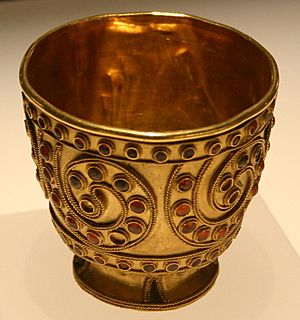Trialeti-Vanadzor culture facts for kids

The Trialeti-Vanadzor culture was an ancient civilization that lived in the areas of Georgia and Armenia. It is named after the Trialeti region in Georgia and the city of Vanadzor in Armenia. This culture existed a very long time ago, from the late 3rd millennium BC to the early 2nd millennium BC. That's about 4,000 to 5,000 years ago!
This culture grew out of an earlier one called the Kura-Araxes culture. Some experts think the people of Trialeti-Vanadzor might have spoken an early form of Indo-European languages. Later, this culture helped create the Lchashen-Metsamor culture. It might also be linked to groups like the Hayasa-Azzi and the Mushki, who are mentioned in ancient texts from the Hittites and Assyrians.
Contents
When Did This Culture Live?
The Trialeti-Vanadzor culture began to really grow and become important around 2000 BC. Before them, the Shulaveri-Shomu culture lived in this area from 6000 to 4000 BC. Then came the Kura-Araxes culture.
During the later part of the Middle Bronze Age (around 1700–1500 BC), the Trialeti-Vanadzor culture was one of several important cultures in the South Caucasus region. Other cultures like Karmir Berd and Sevan-Uzerlik also lived nearby.
Pottery found in places like Ani and Küçük Çatma in Turkey, and Sos Höyük IV, looks very similar to the pottery from Trialeti. This shows that these cultures might have traded or shared ideas.
Amazing Burials: Kurgans
The people of the Trialeti-Vanadzor culture were known for their special burial mounds called kurgans. These were large mounds of earth and stone built over graves. The kurgans show that some people in this society were very important and rich.
Inside these rich burials, archaeologists found many amazing things. They found gold objects, painted pottery, and even four-wheeled carts! The gold objects were similar to those found in ancient Iran and Iraq. This suggests that the Trialeti-Vanadzor people had connections with other advanced cultures far away.
They also used tin to make bronze, which was a very important metal at the time. Sometimes, they even cremated (burned) the bodies before burial.
One amazing discovery was a large pot (a cauldron) found in Trialeti. It looked almost exactly like a cauldron found in a famous ancient grave in Mycenae, Greece! This shows that the Trialeti-Vanadzor culture had ties with powerful cultures in the ancient world, including those around the Aegean Sea. Their pottery, especially the painted kind, also looks like pottery found near Lake Urmia in Iran.
Archaeologists first started digging at the Trialeti site in the 1930s and 1940s. They found 46 burial mounds! Later, in the 1950s and 1960s, they found six more.
Early Kurgan Burials
Some earlier kurgans, like those found in Martqopi, are similar to the first Trialeti kurgans. These early kurgans are part of what is called the Martkopi-Bedeni period. This period is seen as a stepping stone to the Middle Bronze Age.
How They Buried Their Dead
The way the Trialeti-Vanadzor people buried their dead was very special. Important people were buried in huge, rich graves under earth and stone mounds (kurgans). These graves sometimes included four-wheeled carts, which were very valuable. Many gold items were also found in these graves. These gold items were similar to those found in Iran and Iraq, showing connections to other regions. They also worked with metals like tin and arsenic.
This type of burial, using a mound (or "tumulus") and including wheeled vehicles, is similar to the practices of the Kurgan culture. Some experts believe the Kurgan culture was linked to the people who first spoke Proto-Indo-European, a very old language that many modern languages come from. The black pottery found in early Trialeti kurgans is also similar to pottery from the Kura-Araxes culture.
The large amount of wealth found in these burial kurgans is very impressive. This practice of burying rich items with the dead was probably influenced by older, powerful civilizations to the south, in a region called the Fertile Crescent.
The style of pottery from Trialeti-Vanadzor is thought to have developed into the pottery found in eastern Turkey during the Late Bronze Age. This pottery has been linked to the movement of the Mushki people.
See also
 In Spanish: Cultura de Trialeti para niños
In Spanish: Cultura de Trialeti para niños
- Kura-Araxes culture
- Lchashen-Metsamor culture
- Shulaveri-Shomu culture
- Prehistoric Georgia
- Prehistoric Armenia

